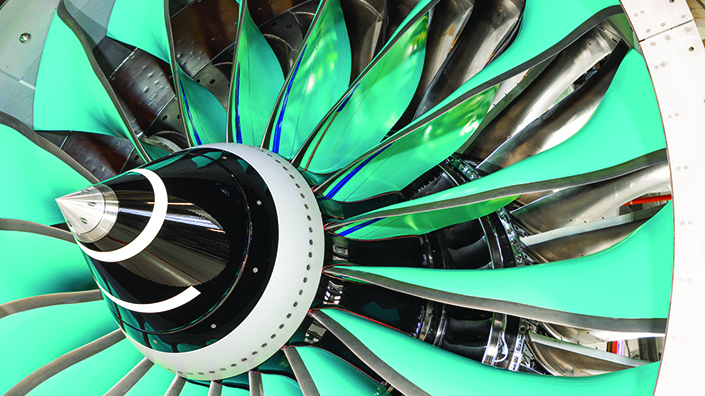“The first key point to note is that there is no silver bullet,” says Jenny Kavanagh, chief strategy officer at Cranfield Aerospace Solutions. “This means we’ve got a complex problem to solve, but it also means we have quite a lot of levers to pull. Another key point is that there is no viable way to decarbonise aviation that does not involve hydrogen.”
Kerosene and heavy fuel oil currently meet the bulk of demand for the marine and aviation industries, and it’s estimated that the total consumption of marine fuels accounts for 5% of global oil demand.
Whilst zero-emissions technologies are being matured and developed, aerospace companies continue to evolve their aircraft and engines. An aircraft coming off an Airbus production line today, for example, is 30% more efficient than it was 20-30 years ago.
“They’re still fuelled by kerosene, but they’re burning less of it, which is only a good thing,” says Kavanagh. “We can also look at redesigning airspace. How can we make flights more direct? How can we mitigate holding patterns above airports? Again, it’s all about burning less fuel and being more efficient.
“Aerospace is not the worst carbon dioxide polluter on the planet,” she continues. “Far from it. But it is the only one that pollutes at altitude. Contrails have an effect on global warming over and above that of carbon dioxide, so it’s a good idea to try and manage those. There is technology appearing today that helps predict where those contrails are going to form and avoid them on a flight-by-flight basis, which is great.”
Question marks over batteries
A lot has been written about electric and hybrid-electric aeroplanes over the past few years. But, simply put, these solutions won’t work for commercial and shipping airliners.
“Batteries are great, they produce zero emissions, but 1kg of battery produced a tenth of the energy density of 1kg of kerosene,” says Kavanagh. “That’s not good for aviation where weight is king. Unfortunately, batteries are only really good enough for small aircraft, up to about five seats.”
SAF is seen as a short- to medium-term solution as it can be used as a direct replacement for kerosene. Currently, it is certified to a 50% blend, but the industry aims to increase that to 100% by 2030. SAF isn’t perfect because it contains carbon, but this has recently been sucked from the air (either naturally or by technological means) before being released, therefore it’s seen as essentially offsetting itself.

Jenny Kavanagh
There are two types of SAF: biofuels and synthetically produced SAF. Biofuels have been around for a while and are used in demonstration flights and in non-commercial applications. Airbus uses 5% blend, for example, in its Beluga aircraft, which ship large parts from one place to another. The downside for biofuels is that you need a lot of it to replace kerosene and, according to Kavanagh, there just isn’t enough feedstock. This is where synthetic fuels come in. They are made by capturing CO2 from the air and combining it with green hydrogen.
Kavanagh says: “The great thing about SAF is that you don’t need new refuelling infrastructure, you can use the kerosene infrastructure. But scaling up the production is a challenge, it’s expensive, and the fuel itself is expensive because of the process used to make it.”
Per 1kg of each, hydrogen has three times the energy density of kerosene, which is why it makes such a tantalising fuel for aviation.
Potential of hydrogen
Jessica Kennedy, project executive for the hydrogen demonstrator project at Rolls-Royce, says: “That’s absolutely huge for us, it’s key that we can optimise and turn that into propulsive efficiency because the technologies we’re supporting and developing as part of our demonstrators, such as the UltraFan, build upon traditional gas turbine technologies with hydrogen as a fuel in the combustion system instead of kerosene.”
There are two main ways that power can be created from hydrogen. One is fuel cells, which take hydrogen and convert it to electric power to drive an electric motor which in turn drives a propeller.
“This technology will be the first that you will see come into service,” Kavanagh explains. “Cranfield Aerospace is working on fuel-cell hydrogen propulsion systems that we want to get into commercial service in 2026. That’s this decade, and it will be here. We’re not quite at single-aisle (100-seat) aircraft yet, but that’s not to say that fuel-cell technology can’t be made to go that big.”
Storage challenge
The second technology is combusting hydrogen directly in an engine, in the same way kerosene is used. Unlike in fuel cells, where the only emissions are water and heat, when hydrogen is combusted, it produces nitrogen oxides (NOx).
“But that’s a hell of a lot better than kerosene,” adds Kavanagh. “Even if it’s slightly worse than fuel cells, it has the potential to be applied to larger aircraft right now.”
The next challenge is storage. Hydrogen can be stored in gaseous or liquid form. In gaseous form it must be stored in highly pressurised, heavy tanks, which suits it for use in small aircraft. However, it’s a relatively simple and mature technology that’s already used in other industries.
Airbus’s ZEROe development network is assessing the infrastructure challenges by learning from other sectors how they handle hydrogen in cryogenic form.
“It can get into service quickly, and proves that hydrogen is safe for use in aviation,” says Kavanagh. “It will require new infrastructure but, because the operations it will be applied to, and the aircraft, are fairly small, it’s not a huge undertaking. It’s still not easy, but it’s a lot easier than liquid, which is a long-term solution.”
Liquid hydrogen, on the other hand, doesn’t require large, heavy tanks, but it does require being cooled to -253°C, which is cryogenic. That has significant challenges. It also takes up four times the volume of kerosene, so it will drive new aircraft design, which is another reason it is taking longer.
Like SAF, vast quantities of hydrogen will be required. It’s predicted that Heathrow airport alone will need 1,300 tonnes of liquid hydrogen by 2040 which presents a major infrastructure challenge to produce, transport and store all that hydrogen.
Airbus released four future concept aircraft designs in 2020 that can theoretically hold 100-200 passengers and travel 1,000-2,000 nautical miles either running on liquid hydrogen-powered gas turbines, liquid hydrogen-powered turboprop, or a fully electric propulsion unit. The fourth is a ‘blended wing body’ design that gives designers a lot of options on the structure of the hydrogen system.
Developing aircraft concepts
Solange Baena-Zambrana, UK lead on the Airbus Aviation Environmental Roadmap, says: “These designs are progressing really well. We’re still not in a position to say which concept will go forward as we’re still looking into the technological breaks that are required to make these concept aircraft work and viable.
“The ambition is to announce which of these aircraft we’ll be working on by 2025, which means that we can then launch a new programme between 2026 and 2028 with the ambition to have these aircraft enter into service in 2035, aligning with many of the environmental roadmaps, UK or global.”

Solange Baena-Zambrana
A critical issue for three of these concepts is the storage of the liquid hydrogen, so the key technology is the tank and how it can be pressurised and made safe to fly.
Baena-Zambrana says the company plans to use twin-walled vacuum-insulated tanks but is still looking at other options.
Combustion method
Similarly, Rolls-Royce sees three main challenges when replacing kerosene with hydrogen. The first is how to combust it as there is a significant difference between the two fuels. The second is how to deliver it from -250°C to room temperature gas and optimally meter it into the combustion system to give the required efficiency. Finally, how can all of this be integrated into existing gas-turbine housing designs, including thermal and power management?
Kennedy says: “We’ve got a range of testing that we’re doing across our hydrogen value stream from materials testing, thinking about things like hydrogen embrittlement through the gas turbine, building that up through components, subsystem, fuel system, and then culminating in ground test engines based on our modified Pearl 15 that we will be looking to progress through from 2024 onwards.”

Rolls-Royce UltraFan could work with hydrogen as a fuel instead of kerosene (Credit: Rolls-Royce)
Rolls-Royce is working with more than 60 partners across industry and academia with the support of UK, EU and German funding agencies for the development of the various technologies. The company also has some key, novel partnerships, such as one with EasyJet which is helping it to think differently about approaching these challenges.
“It has to be done,” says Kavanagh. “This is not impossible; we have a track record of solving really complicated problems. This is not a technology challenge. This is a funding and policy challenge.” Policy signals are supporting the uptake of hydrogen-derived fuels at both UK and EU level. However, these are not on the scale that’s required to meet the targets set out in the Paris agreements and are just one component that will drive the adoption of hydrogen-derived fuels.
Clear message required
Baena-Zambrana says: “We need to align our strategies and messages that we are giving to the public but also to government. We need to make sure we understand the issues, the challenges around these, how much hydrogen we need, how much energy we need to produce the hydrogen, the challenges in infrastructure.”
All of them agree that policymakers need to recognise that green hydrogen will continue to be in limited supply in the coming decades and should therefore be targeted towards sectors – such as aviation – that have no more efficient routes to decarbonisation.
Jane Ashton, sustainability director at EasyJet, says: “That’s one of the reasons why we have joined with a number of partners to create the Hydrogen in Aviation Alliance, which was launched at the House of Commons in September 2023. We will be working with government to highlight the milestones and the policy framework that will need to be put in place to enable hydrogen in aviation to become a reality. Policies such as making sure that hydrogen is equal to SAF in frameworks such as the emissions trading scheme, policies such as simply linking emissions to aviation taxes rather than the blunter per-person taxes that we’re seeing. Also, a number of policy moves to incentivise aircraft and engine producers to produce low- and zero-carbon technology and to incentivise airlines to take those up.”

Jane Ashton
Note of optimism
Ashton adds that there are reasons to be optimistic about the future of hydrogen in aviation. For example, it wasn’t realistically being discussed five years ago as a prospective fuel used in short-haul and regional aviation, but now it’s “absolutely on the cards”. She points towards small operators and start-ups such as ZeroAvia, H2Fly and Universal Hydrogen conducting test flights.
Kavanagh agrees: “Zero-emissions flight is much, much closer than you think it is.”
IMechE will publish a green paper on aerospace this summer. Check the home page for more information.
EasyJet maps the future for fuels
Over the past three years, UK-based low-cost airline EasyJet has been mapping and modelling ways it can decarbonise. According to the company’s sustainability director, Jane Ashton, EasyJet is already just under 20% more carbon efficient than the global short-haul average.
“Throughout 2020 and 2021,” she says, “we worked with the Science-Based Targets initiative, NGOs such as WWF and the International Centre for Clean Transportation, and other experts and airlines, to map what the science-based decarbonisation trajectory should be for aviation and how that would align with other less-polluting sectors’ decarbonisation trajectories.”
That work was published at COP26, and that enabled EasyJet to map its own decarbonisation trajectory. Ashton says the company has set a target of 35% carbon-intensity reduction by 2035. This is based on current technologies, such as replacing 80% of its fleet by the early 2030s with the latest Airbus Neo aircraft which are each at least 15% more efficient than the aircraft they’ll replace. Operational efficiencies are being pursued, including single-engine taxiing and more frequent engine washing, and more sophisticated software and AI applications. For instance, descent profile optimisation software has been retrofitted to 272 aircraft in EasyJet’s fleet over the past nine months which, Ashton says, has provided “over 1% improvement in carbon efficiency”.
Modernisation needed
“Another lever between now and 2035 is airspace modernisation,” says Ashton. “That alone could be up to about 10% carbon-efficiency improvements across Europe. We’re implementing measures but also advocating governments and other airspace providers to implement that and sustainable aviation fuels which will be mandated to use.
“Across the EU 6% of all fuel uplifted from 2030 will need to be sustainable aviation fuel, and that could be up to 10% in the UK. So, a very meaningful lever to decarbonise, but not a silver bullet.”
Want the best engineering stories delivered straight to your inbox? The Professional Engineering newsletter gives you vital updates on the most cutting-edge engineering and exciting new job opportunities. To sign up, click here.
Content published by Professional Engineering does not necessarily represent the views of the Institution of Mechanical Engineers.